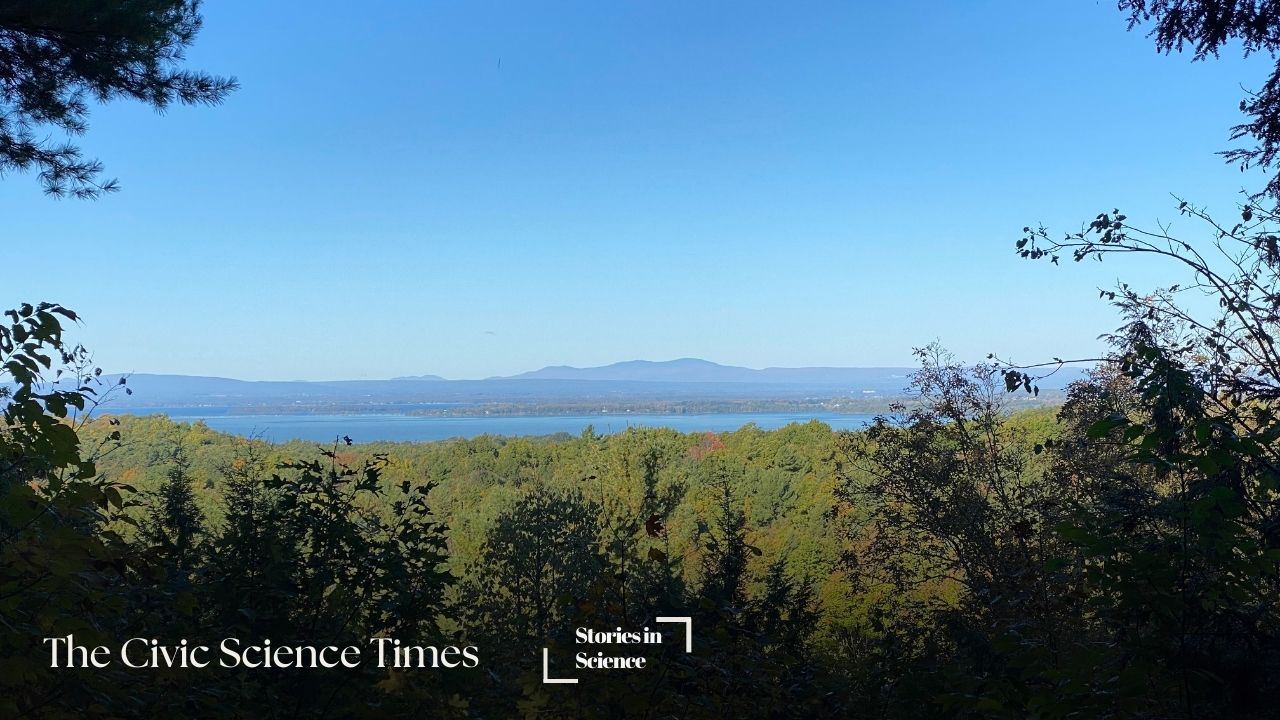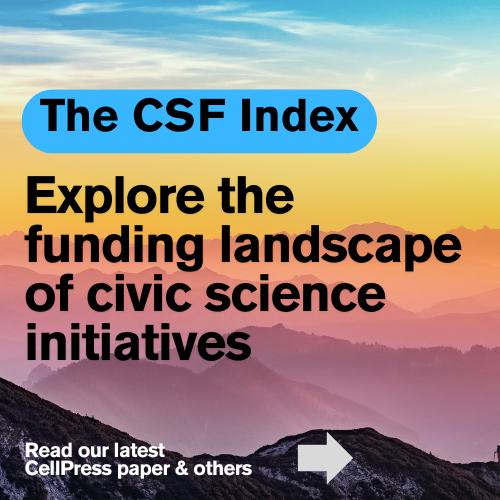CSO - Stories in Science
Finding inspiration in nature to fuel my climate change research
Suddenly, a trip that was supposed to recharge and relax me after a roadblock in my work was having the opposite effect; giving me a prime view of what is exactly at stake if I do not succeed.

Vyshnavi Vennelakanti is a postdoctoral researcher working in the field of computational chemistry at Princeton University. She completed her PhD in Chemistry at Massachusetts Institute of Technology. Her current research investigates the sustainable synthesis of ammonia using computational chemistry methods. Outside of her research, she is passionate about mentoring and science communication. Vyshnavi enjoys singing, hiking, knitting, birding, and traveling. Through the narrative below, she hopes to humanize the scientist behind the science and let other scientists know that they are not alone while facing obstacles along their research journey. You can find her on Twitter @Vyshnavi_1812 and reach her via email.
Story Key Points:
- Research is nothing short of a rollercoaster ride where the ups and downs are the breakthroughs and obstacles we encounter along the way.
- It so happens that, at times, the problems we try to tackle in the lab have effects that extend beyond the lab, making it hard to decouple work and personal lives.
- No matter what, never give up. As long as we continue to work toward our goals – it does not matter the pace – we are making progress, and that is taking us one step closer to the destination.
As I was running out of breath and experiencing a sharp pain in my left leg, I told myself, “It is all in the mind.” This is my favorite mantra which I chant while I am on a strenuous hike to tell myself that as long as I am mentally strong, I can make it. However, this time I felt my body respond, “It is not all in your mind. It is very much in your lungs and legs”. I started the hike at Niquette Bay State Park in Colchester, Vermont with unrivaled enthusiasm on the first Sunday of October 2024. While the pleasant Fall weather kept me going, hiking for more than five miles on a trail that was slippery – thanks to the recent rainfall – started to wear me out. I finally reached the summit and called out to nature to show me what I have come all the way here for: trees in bright yellows, oranges, and reds – the fall foliage!
Instead, I saw a sea of green. I kept blinking my eyes in hopes that I would eventually see a color other than green. Exasperated, I fell to my knees and let out a sigh of despair. Looking out, I thought about the very long journey I undertook, all the way from New York City to Burlington, Vermont. As I scrambled to find a window seat that would offer me the best views during the scenic Ethan Allan Express train ride, I was excited to travel for more than seven hours to see the renowned fall colors of Vermont. While I enjoyed the breathtaking views of the Hudson River, as we entered the Green Mountains, I could not see anything outside the window as it was dark in the evening. I had to contain my excitement for the next day when I hoped to see the bright fall colors in the light of day. I was building castles full of expectations in the air about the stunning fall foliage, unaware that the reality would bring them crumbling down in an instant.
As a chemist, when I look at fall foliage, my first thoughts are always about the chemicals behind the brightly colored leaves. The green color of the leaves comes from the chemical compound, chlorophyll. Chlorophyll absorbs red and blue wavelengths from the sunlight, as a result of which the reflected light from the leaves appears green. Other compounds such as flavonoids and carotenoids are also present in the leaves, but they are generally masked by higher levels of chlorophyll. While flavonoids are responsible for the yellow color of leaves, carotenoids contribute towards the yellow, orange and red hues. Some trees also synthesize anthocyanins (compounds related to flavonoids), which provide bright red and purple colors to the leaves. The chemistry behind fall colors is nothing short of magic.
As I was lost in this train of thought, the loud call of a goose whisked me back to the present where the greenery of the trees came into my focus. As I stared into it, I wondered why the fall colors were not at their peak, contrary to the predictions. I remember the Uber driver casually mentioning how fall colors are delayed this year and how that has been the case for the past few years. I started to wonder if it had anything to do with the increasing global temperatures and the changing climate. That was when a recent study about climate change effects on peak fall foliage in Acadia National Park came to my mind.
While a plethora of factors affect the timing of peak fall foliage, this study discussed how September temperatures seem to be the most critical variable in dictating when peak fall foliage can be observed. As we move from summer into the fall, the shorter days and reduced sunlight result in slower chlorophyll production and increased decomposition of existing chlorophyll in the leaves. As the chlorophyll fades, compounds like flavonoids and carotenoids are revealed, which gives leaves their fall coloration. However, the increasing temperatures could result in the continued production of chlorophyll well into the fall, as a result of which the leaves hold on to their green color longer, thus delaying the onset of fall colors. As per future climate projections, peak fall colors in Acadia could be delayed well into early November by 2060, and this scares me.
I hit a roadblock two months before my hike with modeling the chemical reaction of ammonia synthesis.
In that moment of realization and understanding, I couldn’t help but relate this experience to my work. I am a chemist; however, I am not a chemist that experiments with chemicals in labs. I am a computational chemist, i.e., I do chemistry on computers. During my PhD, I investigated C-H activation chemistry, which is the conversion of a carbon-hydrogen (C-H) bond to a carbon-carbon (C-C) or carbon-hydroxyl (C-OH) or carbon-halogen (C-X) bond. I worked towards a better understanding of these reactions because they play an important role in DNA repair, medicinal chemistry, and the materials industry while promising a shift towards sustainable and green chemistry.
When I started my postdoc, I switched gears a little and took up research that addresses the climate change crisis. I am currently working on the sustainable synthesis of ammonia – the second most produced chemical in the world which is responsible for half of the world’s food supply. Industrial production of ammonia consumes roughly 2% of global energy output every year and produces half a billion tons of carbon dioxide gas [1-3]. Carbon dioxide accounts for ca. 76% of all greenhouse gases and makes the problem of global warming much worse. Using computational chemistry methods, I am working towards identifying sustainable ways to produce ammonia without any carbon dioxide emissions in the process.
As I was working on this research problem, I hit a roadblock two months before my hike with modeling the chemical reaction of ammonia synthesis. Despite trying multiple ways to resolve it, I could not move forward. Having worked day in and day out on this problem without any success, I decided to take a break from work over a long weekend. That is when I started my journey to Vermont to do a couple of fall foliage hikes and reset. I hoped to get back to work with a refreshed mind after the break. But though physically present in Vermont, my thoughts wandered back to my research, and how I must find a way to overcome the bottleneck in my work and play my part in addressing climate change.
I could see the consequences of climate change – the very problem that I am trying to address – affect the world around me. In that moment, the problem of climate change felt personal; it felt like my problem to solve. Suddenly, a trip that was supposed to recharge and relax me after a roadblock in my work was having the opposite effect; giving me a prime view of what is exactly at stake if I do not succeed. I felt my heart skip a few beats as the gravity of the situation sank in. After the initial panic, I took a few deep breaths to compose myself. Eventually, my heart went back to its normal rhythm as I tackled my thoughts into the present moment.
Although I was disappointed with not being able to see the fall foliage, it was nevertheless a very scenic hike. I took one final look from the summit before I started my descent back to the trailhead. As I continued, I noticed what I believed was a maple tree beginning to show some fall colors. While this was not what I expected to see, it gave me some hope. The fall foliage has been delayed but has not been skipped entirely. I stopped at the tree and took a fallen leaf into my hand. The bright orange-red color of the leaf brought a smile to my dejected face.
It was heartening to look at this tree which was on its way to turning into something much more beautiful. I found inspiration in nature, and this motivated me to go back to work on my research problem. And I am not going to give up on it because of a few roadblocks. After all, as John Lennon said, “It will be okay in the end. If it is not okay, then it is not the end.”
Additional Readings
1. X. Liu, A. Elgowainy, and M. Wang, “Life cycle energy use and greenhouse gas emissions of ammonia production from renewable resources and industrial by-products”, Green Chem., 22 (17), 5751-5761 (2020).
2. S. Ornes, “Green ammonia could produce climate-friendly ways to store energy and fertilize farms”, Proc. Natl. Acad. Sci. U.S.A., 118 (49) e2119584118 (2021).
3. V. Kyriakou, I. Garagounis, A. Vourros, E. Vasileiou, and M. Stoukides. “An Electrochemical Haber-Bosch Process”. Joule, 4 (1), 142-158 (2020).
ABOUT: Stories in Science is a special series of The Civic Science Observer. The main aim is to document the first-hand accounts of the human stories behind the science being published by scientists around the world. Such stories are an important element behind the civic nature of science.
SUBMISSION: Click here to access the story guidelines and submission portal. Please note that not all stories are accepted for publication. After submission, we will let you know whether we have selected the story for the review process.
Vyshnavi Vennelakanti is a postdoctoral researcher working in the field of computational chemistry at Princeton University. She completed her PhD in Chemistry at Massachusetts Institute of Technology. Her current research investigates sustainable synthesis of ammonia using computational chemistry methods. Outside of her research, she is passionate about mentoring and science communication. Vyshnavi enjoys singing, hiking, knitting, birding, and traveling. Through the narrative above, Vyshnavi hopes to humanize the scientist behind the science and hopes to let other scientists know that they are not alone while facing obstacles in their research journey. You can find her on Twitter @Vyshnavi_1812 and reach her via email.

-
Civic Science Observer1 month ago
What are the objectives of the Neurotech Justice Accelerator at Mass General Brigham?
-
Civic Science Observer2 weeks ago
Meet the New Hampshire organization changing the way we see insects
-
Civic Science Observer3 weeks ago
Dear Colleagues: Help us understand the national impacts of federal science funding cuts on early career researchers in academic laboratories
-
Civic Science Observer2 months ago
Some of the key takeaways from the 2024 Communicating Discovery Science Symposium in South Africa























